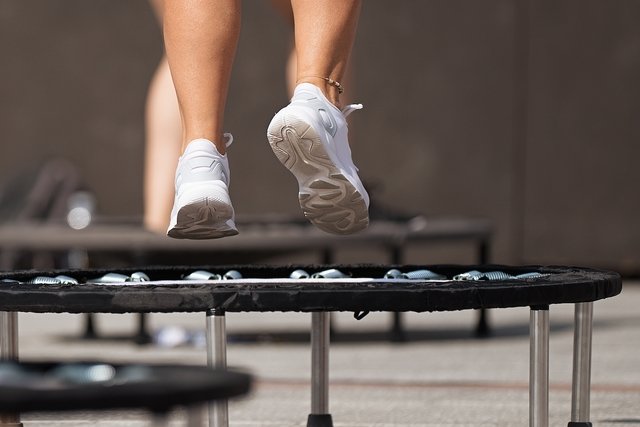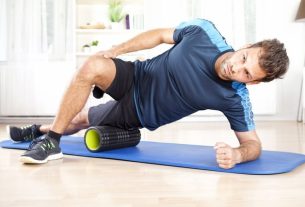The jump class is a physical exercise performed on a “mini trampoline” that has several health benefits, such as helping to lose weight, reducing body fat, increasing lean mass and combating cellulite, as it increases caloric expenditure, and in a 45-minute class it is possible to lose up to 600 calories.
Jumping exercises require good motor coordination and are performed to the sound of loud, fun music, with choreographies that may initially be simple, but become increasingly more elaborate, depending on the person’s physical conditioning, requiring some care to avoid injuries. , such as maintaining correct posture, wearing appropriate sneakers and hydrating the body.
Jumping is considered a high-intensity, low-impact aerobic physical activity for the joints, as the impact is absorbed by the mini-trampoline. However, it is important that before starting classes, a doctor is consulted to assess physical conditions and general health, to avoid injuries or discomfort during classes.

Benefits of Jump class
Jump classes have several health benefits, which are:
- To lose weight;
- Decrease body fat;
- Increase to lean mass;
- Activate metabolism;
- Increase the activation of the lymphatic system;
- Strengthen the immune system;
- Detoxify the body;
- Tone the leg and gluteal muscles, as well as the calves, arms and abdomen;
- Improve physical, cardiovascular and respiratory conditioning;
- Improve body contour;
- Improve motor coordination and balance;
- Increase bone mass;
- Prevent osteoporosis;
- Decrease stress.
Furthermore, jump classes help reduce cellulite, as they stimulate blood and lymphatic circulation, reducing swelling and increasing the elimination of toxins. Discover other exercises to get rid of cellulite.
The benefits of jumping classes are usually noticed after 1 month of classes, which must be practiced regularly, with the guidance of a physical educator.
Precautions for taking a jump class
Some precautions are important to take a jump class and avoid injuries, such as:
- Check that the trampoline is in perfect condition, such as checking that the springs are intact and complete, and that it has a safety net;
- Position the trampoline at a safe distance from other trampolines in the class, or away from sharp furniture or hard objects if used at home;
- Wear suitable sneakers;
- Wear comfortable clothing that facilitates perspiration;
- Stretch before starting the exercises;
- Maintain correct posture, with the head, neck and spine aligned;
- Jump keeping your knees slightly bent;
- Always keep your abdomen contracted and your torso slightly tilted forward;
- Support your entire foot when jumping, avoiding using your toes during impact;
- Keep your body hydrated during exercise by taking small sips of water.
In addition, a medical consultation must be made before starting jump classes, to assess physical, cardiovascular and respiratory conditions, and general health status, which is even more important in cases of sedentary people or those who wish to lose weight. .
When not to do
Jump classes, although very beneficial, are not recommended for pregnant women, people who have back or joint problems, people who are very overweight and people with varicose veins.
These contraindications exist because jump classes have a great impact on the ankle, knee and hip joints, which can aggravate conditions that the person already has or generate new changes, as in the case of people who are very overweight, for example.
Bibliography
- HOCHSMANN, C.; et al. Oxygen uptake during mini trampoline exercise in normal-weight, endurance-trained adults and in overweight-obese, inactive adults: A proof-of-concept study. Eur J Sport Sci. 18. 5; 753-761, 2018
- CUGUSI, L.; et al. Effects of a mini-trampoline rebounding exercise program on functional parameters, body composition and quality of life in overweight women. J Sports With Phys Fitness. 58. 3; 287-294, 2018
- TAY, ZM; et al. Trampoline Versus Resistance Training in Young Adults: Effects on Knee Muscles Strength and Balance. Q Exercise Sport. 90. 4; 452-460, 2019
- POSCH, M.; et al. Effectiveness of a Mini-Trampoline Training Program on Balance and Functional Mobility, Gait Performance, Strength, Fear of Falling and Bone Mineral Density in Older Women with Osteopenia. Clin Interv Aging. 14. 2281-2293, 2019
- FRICKE, A.; et al. Mini-Trampoline Jumping as an Exercise Intervention in Postmenopausal Women to Improve Women Specific Health Risk Factors. Int J Prev Med. 12. 10, 2021
- NAM, DC; et al. Femoral neck stress fractures after trampoline exercise: A case report. World J Clin Cases. 9. 18; 4783-4788, 2021

Sign up for our newsletter and stay up to date with exclusive news
that can transform your routine!
Warning: Undefined array key "title" in /home/storelat/public_html/wp-content/plugins/link-whisper-premium/templates/frontend/related-posts.php on line 12
Warning: Undefined array key "title_tag" in /home/storelat/public_html/wp-content/plugins/link-whisper-premium/templates/frontend/related-posts.php on line 13





